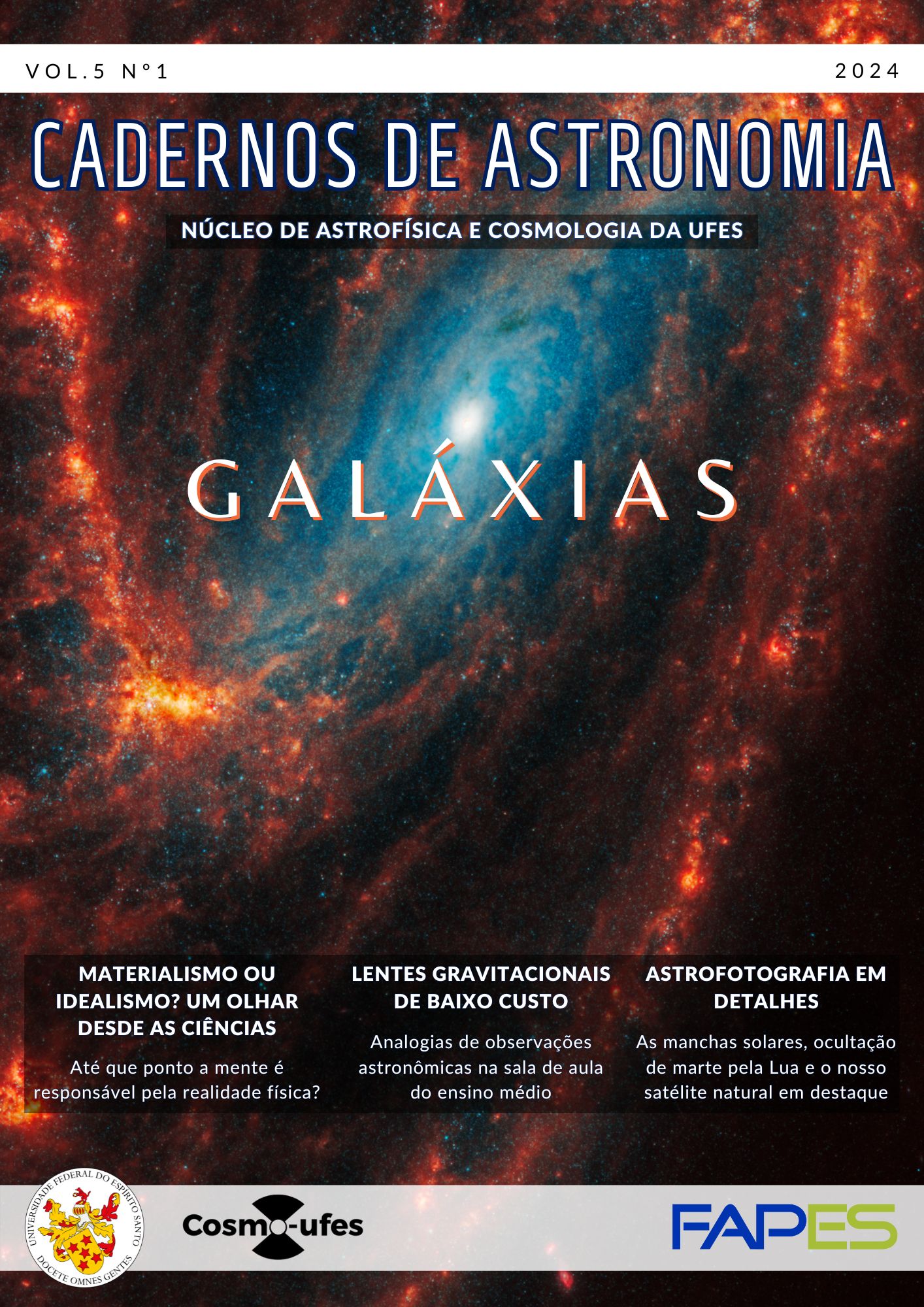A Via Láctea, a nossa galáxia
DOI:
https://doi.org/10.47456/Cad.Astro.v5n1.43824Palavras-chave:
Via Láctea, Estrutura da galáxia, dinâmica da galáxiaResumo
Apresentamos a Via Láctea, nossa Galáxia, primeiro com uma introdução de como a vemos no céu, e a seguir com a história dos primeiros passos de descobertas, que levaram a conclusão de que a Galáxia não é o próprio Universo, mas apenas uma entre muitas galáxias.
Descrevemos seus componentes principais (disco galáctico, braços espirais, bojo, barra), mencionando suas dimensões e formas geométricas. Focalizamos as órbitas das estrelas, responsáveis pela manutenção da forma dos componentes. Explicamos as órbitas, a partir das forças gravitacionais que atuam sobre as estrelas
Downloads
Referências
[1] D. Clemens, Massachusetts-Stony Brook Galactic plane CO survey: the galactic disk 1526 rotation curve., The Astrophysical Journal 295, 422 (1985). DOI: https://doi.org/10.1086/163386
[2] L. Fich, M.; Blitz e A. A. Stark, The Rotation Curve of the Milky Way to 2R0, The Astrophysical Journal 342, 272 (1989). DOI: https://doi.org/10.1086/167591
[3] Ž. Chrobáková et al., Gaia-DR2 extended kinematical maps-III. Rotation curves analysis, dark matter, and MOND tests, Astronomy & Astrophysics 642, A95 (2020). DOI: https://doi.org/10.1051/0004-6361/202038736
[4] A. Kalnajs, Spiral structure viewed as a density wave, Publications of the Astronomical 1537 Society of Australia 2(4), 174 (1973). DOI: https://doi.org/10.1017/S1323358000013461
[5] W. d. S. Dias et al., The spiral pattern rotation speed of the Galaxy and the corotation radius with Gaia DR2, Monthly Notices of the Royal Astronomical Society 486(4), 5726 (2019). DOI: https://doi.org/10.1093/mnras/stz1196
[6] L. Marochnik, On the position of the Sun in the Galaxy, Astrophysics 19, 278–283 (1983). DOI: https://doi.org/10.1007/BF01007342
[7] T. Junqueira et al., A new model for gravitational potential perturbations in disks of spiral galaxies. An application to our Galaxy, Astronomy & Astrophysics 550, A91 (2013). DOI: https://doi.org/10.1051/0004-6361/201219769
[8] D. Barros et al., INSERIR TITULO DO ARTIGO, Frontiers in Astronomy and Space Sciences 8, 48 (1981).
[9] T. Antoja et al., Origin and evolution of moving groups-I. Characterization in the observational kinematic-age-metallicity space, Astronomy & Astrophysics 490(1), 135 (2008). DOI: https://doi.org/10.1051/0004-6361:200809519
[10] T. A. Michtchenko et al., Modelling resonances and orbital chaos in disk galaxies - Application to a Milky Way spiral model, Astronomy & Astrophysics 597, A39 (2017). DOI: https://doi.org/10.1051/0004-6361/201628895
[11] T. A. Michtchenko et al., Combined dynamical effects of the bar and spiral arms in a Galaxy model. Application to the solar neighbourhood, Astronomy & Astrophysics 615, A10 (2018). DOI: https://doi.org/10.1051/0004-6361/201833035
[12] J. Bland-Hawthorn e O. Gerhard, The galaxy in context: structural, kinematic, and integrated properties, Annual Review of Astronomy and Astrophysics 54, 529 (2016). DOI: https://doi.org/10.1146/annurev-astro-081915-023441
[13] O. Gerhard e C. Wegg, The Galactic Bar, in Lessons from the Local Group (Springer International Publishing, 2015), 43–52. DOI: https://doi.org/10.1007/978-3-319-10614-4_4
[14] M. López-Corredoira et al., A major star formation region in the receding tip of the stellar galactic bar. II. Supplementary information and evidence that the bar is not the same structure as the triaxial bulge previously reported, The Astronomical Journal 118(1), 381 (1999). DOI: https://doi.org/10.1086/300911
[15] E. Valenti et al., Stellar density profile and mass of the Milky Way bulge from VVV data, Astronomy & Astrophysics 587, L6 (2016). DOI: https://doi.org/10.1051/0004-6361/201527500
[16] B. W. Carney et al., A survey of proper motion stars. XIII. The Halo population, The Astronomical Journal 112, 668 (1996). DOI: https://doi.org/10.1086/118042
Downloads
Publicado
Como Citar
Edição
Seção
Licença
Copyright (c) 2024 Jacques Lépine

Este trabalho está licenciado sob uma licença Creative Commons Attribution 4.0 International License.






